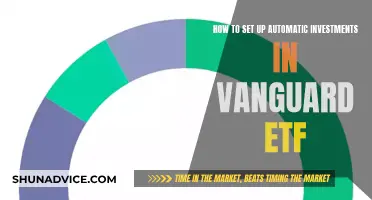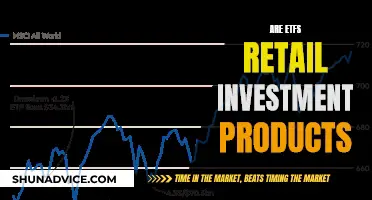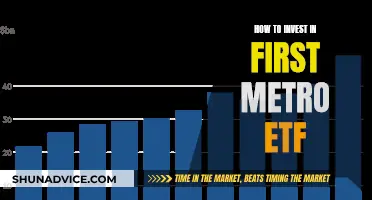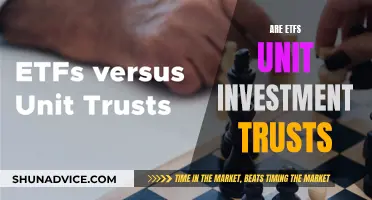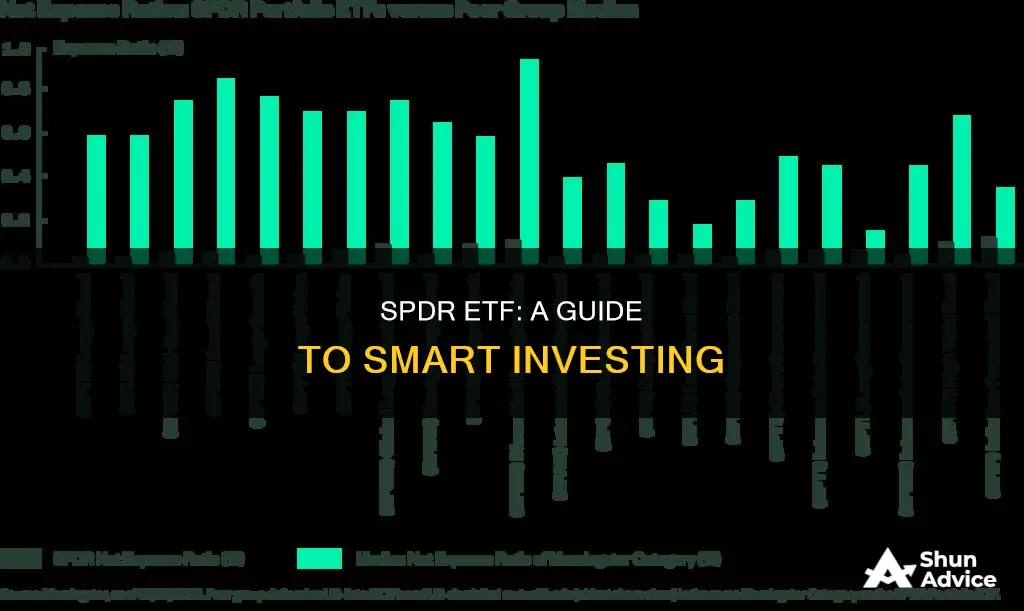
SPDR ETFs, or Standard & Poor's Depository Receipts, are a type of exchange-traded fund (ETF) that first launched in 1993. SPDRs are often referred to as spiders and are known for providing investors with broad diversification and flexible market exposure. With over 140 SPDR ETFs currently available, investors can choose from a wide range of options to build a solid, low-cost portfolio. SPDRs differ from mutual funds in that they have a fixed number of shares that are bought and sold on the open market, trading like stocks on exchanges. SPDRs can be purchased through brokerage accounts, and shares can be bought and sold like any other stock. SPDRs also have the advantage of being used as hedging instruments, providing an opportunity for investors to manage risk.
| Characteristics | Values |
|---|---|
| First SPDR ETF | SPDR S&P 500 ETF Trust (SPY) |
| Number of SPDR ETFs | 140 |
| SPDR ETF provider | State Street Global Advisors |
| SPDR ETF types | Low-cost, diversified index funds; strategy funds; environmental, social and governance funds (ESG); passive, actively managed funds |
| SPDR ETF suitability | Experienced, hands-on investors; new investors |
| SPDR ETF sectors | Energy, Industrial, Financial, Technology, Communications, Materials, Healthcare, Consumer Staples, Consumer Discretionary, Utilities, Real Estate |
| SPDR ETF investment process | Fund your account; search for the ETF; choose how many shares to buy; choose an order type |
| SPDR ETF performance | Depends on the fund and market conditions |
What You'll Learn

SPDRs are bought and sold like stocks on the open market
SPDRs, or Standard & Poor's Depository Receipts, are a type of exchange-traded fund (ETF) that can be bought and sold on the open market like stocks. They were first introduced in 1993 by State Street Global Advisors, which remains the issuer of SPDR ETFs today.
SPDRs differ from mutual funds in that they have a fixed number of shares that are bought and sold on the open market, rather than being created or redeemed by a mutual fund company at the time of investment. This means that SPDRs trade on exchanges in the same way as shares of stock. As a result, SPDRs can be purchased and sold through a brokerage account, and investors can implement strategies such as stop-loss orders and limit orders.
The price of SPDRs is also influenced by the underlying index they track. For example, the SPDR 500 Trust (SPY), also known as "Spiders", is designed to trade at approximately one-tenth of the level of the S&P 500 index. This means that if the S&P 500 is at 1,800, the SPY shares will trade at around $180.
SPDRs can be bought and sold on margin, and they provide regular dividend payments. They also incur regular brokerage commissions when traded.
Overall, SPDRs offer investors a flexible and accessible way to invest in a diverse range of assets, as they can be traded like stocks while also providing the benefits of an ETF, such as low fees and broad diversification.
Guggenheim S&P Global Water Index ETF: A Smart Investment Move
You may want to see also

SPDRs can be purchased through a brokerage account
SPDRs are flexible and easy to trade. Investors can also employ traditional stock trading techniques, including stop orders, limit orders, margin purchases, and short sales using ETFs. They are listed on major US stock exchanges. Ordinary brokerage commissions apply.
Before investing, consider the funds' investment objectives, risks, charges, and expenses. To obtain a prospectus or summary prospectus, which contains this and other information, call 1-866-787-2257, download a prospectus or summary prospectus now, or talk to your financial advisor. Read it carefully before investing.
If you don’t already have a taxable brokerage account or a tax-sheltered retirement account, check out our lists of the best IRAs and the best online brokers for beginners.
Russia ETF: A Smart Investment Strategy?
You may want to see also

SPDRs can be used to make a concentrated bet on a specific market sector
SPDRs, or Standard & Poor's Depository Receipts, are a type of exchange-traded fund (ETF) that can be used to make a concentrated bet on a specific market sector. SPDRs were first introduced in 1993 by State Street Global Advisors and have since become a cornerstone of many investor portfolios.
For example, let's say an investor believes that the technology sector is poised to outperform the overall market. They can then choose to invest in a Sector SPDR ETF that specifically tracks the technology sector, such as the Technology Select Sector SPDR (XLK). This allows them to make a concentrated bet on the technology sector, potentially profiting handsomely if their predictions come true.
Similarly, if an investor is sceptical about the prospects of a particular sector, they can choose to exclude that sector from their portfolio by investing in all Sector SPDRs except for the one they want to avoid. For instance, if they are nervous about the financial sector, they can invest in all Sector SPDRs except for the Financial Select Sector SPDR (XLF). This allows them to mitigate the risk associated with that specific sector while still maintaining exposure to the overall market.
In addition to providing the ability to make concentrated bets, SPDRs offer several other benefits to investors. They are easily accessible to anyone wishing to invest in the S&P 500 through an ETF, as they trade at approximately one-tenth of the value of the S&P 500. SPDRs also provide diversification benefits, as they can be used to gain exposure to specific sectors or industries within the broader market.
A Smart Guide to Investing in Reliance ETF Shariah Bees
You may want to see also

SPDRs can be used as a hedging instrument
Firstly, selling SPDRs short or buying put options can add an element of hedging to a portfolio. When an investor has a long position in the S&P 500 SPDR ETF or the stock market in general, they will make money if the S&P 500 Index rises. However, if the index falls, they will start losing money on their investments. To mitigate this risk, investors can hedge their bets by shorting the SPDR or buying put options. This practice is known as hedging the market.
Secondly, SPDRs can be used to hedge a portfolio because they trade like stocks. SPDRs are exchange-traded funds (ETFs) that are bought and sold on the open market, just like stocks. This means that SPDRs can be sold short, bought on margin, and used to provide regular dividend payments. These features of SPDRs make them useful for hedging purposes.
Thirdly, SPDRs can be used as a hedging instrument because they offer exposure to specific sectors or market capitalisations. By investing in SPDRs that focus on specific sectors or market capitalisations, investors can hedge their bets and reduce their exposure to a particular area of the market. For example, if an investor is long on tech stocks, they might invest in a SPDR that focuses on the utilities sector to hedge their exposure to the tech sector.
Finally, SPDRs can be used as a hedging instrument because they are based on underlying indexes. The value of each unit in a SPDR ETF reflects the movement of the underlying index it is based on. For example, the SPDR 500 Trust (SPY) is designed to trade at approximately one-tenth of the level of the S&P 500. This means that if the S&P 500 rises or falls, the value of the SPDR 500 Trust will also rise or fall, albeit to a lesser extent. This feature of SPDRs makes them useful for hedging purposes, as investors can use them to offset their exposure to a particular index.
A Guide to Investing in Nifty 50 ETF
You may want to see also

SPDRs are a good investment due to low fees and broad diversification
SPDRs are a good investment option due to their low fees and broad diversification.
State Street Global Advisors, the creator of the world's first exchange-traded fund (ETF), offers about 200 highly regarded SPDR ETFs on the U.S. market. These funds are known for their low fees and broad diversification, making them a great choice for investors.
One of the key advantages of SPDRs is their low expense ratios. For example, the SPDR Portfolio S&P 500 ETF Trust (SPLG) has an expense ratio of just 0.02%, which is significantly lower than that of the more popular SPDR S&P 500 ETF (SPY). With SPDRs, investors can access a wide range of investment options without incurring high costs, which can eat into their returns over time.
In addition to low fees, SPDRs also offer broad diversification. The SPDR Portfolio Developed World Ex-U.S. ETF (SPDW), for instance, provides exposure to 24 international markets and approximately 2,300 stocks across large-, mid-, and small-capitalization firms. This broad diversification helps to reduce country-specific risk and provides investors with a well-diversified portfolio.
Another example of broad diversification is the SPDR Dow Jones Global Real Estate ETF (RWO), which invests in real estate investment trusts (REITs) and real estate operating companies in the U.S. and internationally. By investing in this ETF, investors gain exposure to various real estate sectors, including retail, industrial, and residential properties.
SPDRs also offer sector-specific diversification, allowing investors to focus on particular sectors or industry segments. For instance, the Financial Select Sector SPDR ETF (XLF) tracks the performance of the Financial Select Sector Index within the S&P 500, providing targeted exposure to financial stocks.
The flexibility of SPDRs is another advantage. Investors can choose from a wide range of funds that track different indexes, sectors, or asset classes. This allows investors to build customized portfolios that align with their investment goals and risk tolerance.
In summary, SPDRs are a good investment option due to their low fees, broad diversification across markets and sectors, and flexibility. They provide investors with access to a wide range of investment opportunities, helping them build well-diversified portfolios at a low cost.
A Guide to Investing in the Kotak Nifty ETF
You may want to see also
Frequently asked questions
SPDR stands for Standard & Poor's Depositary Receipt. It is a type of exchange-traded fund (ETF) that tracks the Standard & Poor's 500 index (S&P 500). Each share of a SPDR ETF contains about one-tenth of the S&P 500 index and trades at roughly one-tenth of the dollar value of the S&P 500.
You can buy and sell SPDR ETFs through a brokerage account, just like stocks. You can also employ traditional stock trading techniques such as stop orders, limit orders, margin purchases, and short sales.
As with any investment, there are risks involved. SPDR ETFs can fluctuate in value and can decline significantly in response to the activities of individual companies and general market and economic conditions. There is also the risk of tracking errors relative to the performance of the index.
SPDR ETFs offer wide access to diverse investment opportunities. They are flexible and easy to trade, and they provide investors with an opportunity to match the performance of a market or index. SPDR ETFs also have the advantage of being able to give depth of market exposure through one of the ETFs that track a broader index.


